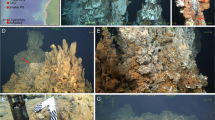Abstract
Jewfish Sink is located in the shallow seagrass flats of the Gulf of Mexico in west central Florida. Jewfish Sink was a submarine spring until the drought of 1961–1962 when it ceased flowing. Today, the sink is an anaerobic marine basin and provides the opportunity to study the implications of saltwater intrusion in coastal karstic areas. The biogeochemistry of Jewfish Sink was studied from summer 2001 through spring 2004. A distinct feature of the sink is the uniform cold temperature (16–17°C) of the deeper anoxic water that does not match groundwater found nearshore or onshore (22–24°C). There are four zones within the sink: oxic zone, transition zone, upper anoxic zone, and anoxic bottom water. The anoxic bottom water does not mix with water from above but may be linked to deep Gulf shelf water through ancient aquifer conduits. The other three zones vary seasonally in oxygen, salinity, and temperature because of limited mixing in the winter due to cooding and sinking of surface water. The walls of the anoxic zones have characteristic microbial mats that are found in other sulfidic karstic features in the area. Bacterial activity appears to be carbon, limited in the anoxic zones where sulfate reduction appears to be the major metabolic process. The reduction of sulfate to sulfide appears to be driven by irregular influexes of organic matter including macroalgae, horseshoe crabs, and stingrays that become entrapped within the sink. Bacterial activity in the oxic zones appears to be phosphate limited. Although the system is partially isolated from the overlying marine ecosystem, organic input from above drives the bacterial anaerobic ecosystem, resulting in a sulfide pump. In this model, sulfide percolates up through the karst and removes oxygen from the overlying sediment, which has likely caused changes in the shallow benthic ecosystem. Jewfish Sink appears to be part of an extensive anoxic subterranean estuary that extends under parts of at least three coastal counties in Florida and serve as a model for the effects of rising sea levels or aquifer mining.
Similar content being viewed by others
Literature Cited
Atlas, R. M. andR. Bartha. 1998. Microbial Ecology: Fundamentals and Applications, 4th edition. Benjamin/Cummings Science Publishing, Menlo Park, California.
Bonacci, O. andT. Rojebonacci. 1997. Sea water intrusion in coastal karstic springs: Example of the Blaz Spring Croatia.Hydrological Sciences Journal-Journal des Sciences Hydrologiques 42:89–100.
Brigmon, R. L., H. W. Martin, T. L. Morris, G. Bitton, andS. G. Zam. 1994. Biogeochemical ecology ofThiothrix spp. in underwater limestone caves.Geomicrobiology Journal 12:141–159.
Burnett, W. C., H. Bokuniewicz, M. Huettel, W. S. Moore, andM. Taniguchi. 2003. Groundwater and pore water inputs to the coastal zone.Biogeochemistry 66:3–33.
Burt, R. A. 1993. Ground-water chemical evolution and diagenetic processes in the Upper Floridian aquifer, southern South Carolina, and northeastern Georgia. U.S. Geological Survey Water-Supply Paper 2392, 76. Washington, D.C.
Capone, D. G. andR. P. Kiene. 1988. Comparison of microbial dynamics in marine and freshwater sediments: Contrasts in anaerobic metabolism.Limnology and Oceanography 33:725–749.
Castanier, S., G. Le Metayer-Leverel, andJ. P. Perthuisot. 1999. Ca-carbonates precipitation and limestone genesis—The microbiogeologist point of view.Sedimentary Geology 126:9–23.
Kohout, F. A. 1966 Submarine springs: A neglected phenomenon of coastal hydrology. Central Treaty Organization (CENTO), Symposium on Hydrology and Water Resources Development, Ankara, Turkey.
Lee, D. 1977. A device for measuring seepage flux in lakes and estuaries.Limnology and Oceanography 22:140–147.
Marella, R. L. 1995. Water-use by category, county, and water management district in Florida, 1950–1990: U.S. Geological Survey Open-File Report 94-521. Washington, D.C.
Moore, W. S. 1999. The subteranean estuary: A reaction zone of ground water and sea water.Marine Chemistry 65:111–125.
Nelson, P. 2003. Index to EPA test methods. U.S. Environmental Protection Agency, New England Region 1 Library, Boston, Massachusetts.
Oguz, T., H. W. Ducklow, andP. Malanotte-Rizzoli. 2000. Modeling distinct vertical biogeochemical structure of the Black Sea: Dynamical coupling of the oxic suboxic, and anoxic layers.Global Biogeochemical Cycles 144:1331–1352.
Parker, G. G. 1975. On the hydrogeology of the Southwest Florida Water Management District. Hydrogeology of West-Central Florida, 19th Field Conference, Southeastern Geological Society, Tampa, Florida.
Parker, G. G., G. E. Ferguson, and S. K. Love. 1955. Water resources of southeastern Florida with special reference to the geology and ground water of the Miami area. U.S. Geological Survey Water-Supply Paper No.: 1255, 965. Washington, D.C.
Rosenau, J. C., G. L. Faulkner, C. W. Hendry, and R. W. Hull. 1977. Springs of Florida. State of Florida, Department of Natural Resources, Bureau of Geology, Bulletin No. 31, 461. Tallahassee, Florida.
Stringfield, V.T. 1936. Artesian water in the Florida Peninsula. U.S. Department of the Interior, Geological Survey, Water-Supply Paper No. 773-C. 195. Washington, D.C.
Swarzenski, P. W., C. D. Reich, R. M. Spechiler, J. L. Kindinger, andW. S. Moore. 2001. Using multiple geochemical tracers to characterize the hydrogeology of the submarine spring off Crescent Beach. Florida.Chemical Geology 179:187–202.
Waller, B. G. 1985. Drought of 1980–82 in southeast Florida with comparison to the 1961–62 and 1970–71 droughts. U.S. Geological Survey Water-Resources Investigation Report 85-4152, 29. Washington, D.C.
Wetterhall, W. S. 1965. Reconnaissance of Springs and Sinks in West-Central Florida. Florida Geological Survey, Report of Investigations No. 39. 42. Tallahassee, Florida.
Yon, J. W. and C. W. Hendry. 1972. Part I, Suwannee Limestone in Hernando and Pasco Counties, Florida. State of Florida, Department of Natural Resources, Bureau of Geology, Bulletin 54:42. Tallahassee, Florida.
Source of Unpublished Materials
Herring, H. J. R. C. Patchen, and G. L. Mellor. unpublished data. Atlas of salinity/temperature and bathymetry for the Gulf of Mexico. Dynalysis of Princeton web page, www.dynalysis.com
Author information
Authors and Affiliations
Corresponding author
Rights and permissions
About this article
Cite this article
Michael Garman, K., Garey, J.R. The transition of a freshwater karst aquifer to an anoxic marine system. Estuaries 28, 686–693 (2005). https://doi.org/10.1007/BF02732907
Received:
Revised:
Accepted:
Issue Date:
DOI: https://doi.org/10.1007/BF02732907




